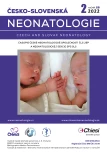National newborn hearing screening in the Czech Republic – database and new methodic
Authors:
V. Chrobok 1; M. Homoláč 1; Jana Krtičková 1; M. Hloušková 1; L. Bilinová 1; E. Čelakovská 1; V. Blanař 2; J. Malý 3; P. Komínek 4; K. Hejduk 5,6; J. Dršata 1
Authors‘ workplace:
Klinika otorinolaryngologie a chirurgie hlavy a krku, LF UK a FN, Hradec Králové
1; Klinika otorinolaryngologie a chirurgie hlavy a krku, Nemocnice Pardubického kraje, Pardubická nemocnice, Fakulta zdravotnických studií, Univerzita Pardubice
2; Dětská klinika, LF UK a FN, Hradec Králové
3; Klinika otorinolaryngologie a chirurgie hlavy a krku, FN Ostrava a LF Ostravské univerzity
4; Národní screeningové centrum, Ústav zdravotnických informací a statistiky ČR, Praha
5; Institut biostatistiky a analýz, LF Masarykovy univerzity, Brno
6
Published in:
Čes-slov Neonat 2022; 28 (2): 82-88.
Category:
Reviews
Overview
Screening of hearing loss in newborns is based on simple organization, comfortable examination, effective measurement, and acceptable price.
The amendment of Newborn hearing screening guidelines by Ministry of Health of the Czech Republic was published in Bulletin of Ministry of Health of the Czech Republic no. 14/2021. Transient evoked otoacoustic emissions (TEOAE) are used for the screening of normal newborns. Automatic auditory brainstem responses (AABR/BERA) are used for screening of high-risk newborns. `Positive screening` stands for new diagnosed (permanent) hearing loss, `negative screening` stands for normal results of TEOAE or AABR in both ears.
The goal of this paper is to provide information about the national database and current methods of newborn hearing screening in the Czech Republic.
Methods and results: the system of Early Hearing Detection and Intervention (EHDI) currently carried out in the Czech Republic consists of three levels: screening in neonatal units, rescreening in specialized ENT departments or phoniatric departments and assessment of hearing threshold in regional ENT pedaudiology centers. The results from the national database are presented in this work. Progressive increase in numbers of screening examinations is demonstrated. Further an overview of current methods and planning of a new national registry for newborn hearing screening is presented.
Discussion: the amendment of Newborn screening guidelines (originally from 2012) was written in 2021 as a result of close cooperation between ENT, neonatologists and pediatrists. The system of screening follows these steps: 1. screening of hearing in normal newborns during first 3 days of life in hospital by neonatal nurses with TEOAE or with AABR/BERA in high-risk newborns; 2. rescreening of hearing between 3–6 weeks of life in ENT department specialized for re-screening of hearing; 3. final diagnosis of hearing loss up to 6 months of life in regional ENT pedaudiology center.
Keywords:
newborn hearing screening – database – national registry – otoacoustic emission – pedaudiology center
Sources
1. Bush ML, Kaufman MR, McNulty BN. Disparities in access to pediatric hearing. Curr Opin Otolaryngol Head Neck Surg 2017; 25(5): 359–364.
2. Dršata J, Havlík R. Foniatrie sluchu. Havlíčkův Brod: Tobiáš 2015.
3. Grandori F. European consensus statement on neonatal hearing (screening finalised at the european consensus development conference on neonatal hearing screening May 1998, Milan, Italy). https://doi.org/10.1080/010503998420577
4. Havlíková E, Poláčková R, Vítečková T, et al. Screeening sluchu fyziologických a rizikových novorozenců metodami OAE a AABR: zhodnocení výsledků. Otorinolaryng a Foniat 2015; 64(1): 17–21.
5. Chrobok V, Dršata J, Janouch M, et al. Nutná spolupráce otorinolaryngologa, neonatologa a pediatra v novorozeneckém screeningu sluchu. Vox pediatr 2017; 17(1): 33–35.
6. Chrobok V, Dršata J, Janouch M, et al. Aktualizace metodiky screeningu sluchu novorozenců. Čas. Lék. Čes. 2019; 158: 221–224.
7. Chrobok V, Dršata J, Janouch M. et al. Screening sluchu novorozenců – současný stav a jak dále? Otorinolaryng a Foniat 2020; 69: 3–10.
8. Komínek P, Chrobok V, Zeleník K, et al. Novorozenecký screening sluchu: význam, současný stav v ČR. Čas. Lék. Čes. 2017; 156(4): 173–177.
9. Metodický pokyn k provádění screeningu sluchu u novorozenců. Věstník MZ ČR č. 7/2012: 18–22.
10. Metodický pokyn k provádění screeningu sluchu u novorozenců. Věstník MZ ČR č. 14/2021: 30–36.
11. Ramkumar V. A review of neonatal hearing screening practices in India. J Hearing Science 2017; 7(1): 9–15.
12. Ricalde RR, Chiong CM, Labra PJP. Current assessment of newborn hearing screening protocols. Curr Opin Otolaryngol Head Neck Surg 2017; 25(5): 370–377.
13. Sloot F, Hoeve H, de Kroon M, et al. Inventory of current EU paediatric vision and hearing screening programmes. J Med Screen 2015; 22(2): 55–64.
14. White KR. Screening programs for hearing loss. In: Luxon L. (ed). Textbook of audiological medicine, clinical aspects of hearing and balance. London: Martin Dunitz, Taylor & Francis group 2003; 339–348.
15. Zeleník K, Havlíková E, Poláčková Z, et al. Otázky související se zaváděním plošného screeningu sluchu v Moravskoslezském kraji. Otorinolaryng a Foniat 2012, 61(2): 112–119.
16. Blanař V, Škvrňáková J, Pellant A, et al. Effectiveness of neonatal hearing screening system: a 12 year single centre study in the Czech Republic. J Pediatr Nurs 2021. https://doi:10.1016/j. pedn.2021.01.019
Labels
Neonatology Neonatal NurseArticle was published in
Czech and Slovak Neonatology

2022 Issue 2
Most read in this issue
- Hyperbilirubinemia – time for change?
- Screening of the neonatal glycemia and its pitfalls
- Weight loss in breastfed full-term newborns
- Streptococcus agalactiae infections in a newborn
